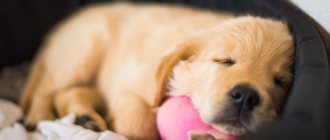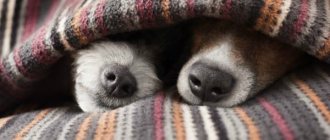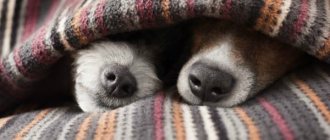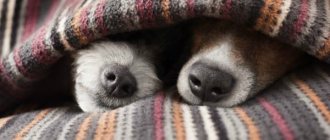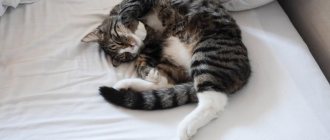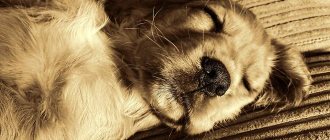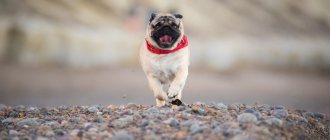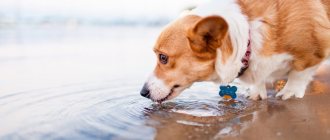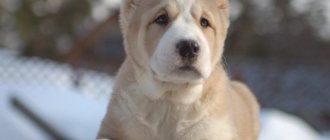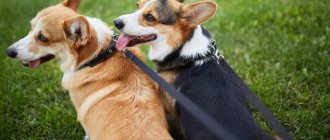When purchasing a little bundle of happiness, people do not quite understand how to treat a new family member. Feeding and walking are simple tasks, but Yorkies require a special approach. First of all, know that the Yorkshire Terrier sleeps a lot. If you adopted a puppy, then be prepared that sleep will make up about ninety percent of your life.
Moreover, at this time the puppies behave restlessly, they can whine, twitch their paws, and bark. Don't think that this is due to nerves - this is how dogs grow and develop. As you grow older, the relationship between wakefulness and sleep evens out. Usually a puppy wakes up at one and a half to two months, goes to the toilet, eats, plays, walks again to relieve itself and falls asleep.
The puppy is most active in the morning and evening, so his sleep is deeper at night, for five to six hours, and during the day - 2-3 hours. A sleeping Yorkshire Terrier may be left alone, while the owners are away on their own business. The older the dog gets, the different the sleep turns out to be. You can observe how the dog gains strength in a short time and then behaves actively for a long time.
In fact, initially the breeder adapts to the pet’s regime, then it adapts to the rhythm. How long does a Yorkie sleep? It is considered to be long, so we will talk about the regime further.
Why does a Yorkie sleep a lot: is it right?
As a dog grows up, it tries to be active most of the time, but this does not mean that it is awake all the time. It is considered normal that when a dog immerses itself in dreams, it spends 16 to 18 hours in this state. This period of time includes all rest for the day. If it seems to you that your Yorkie sleeps all the time, then perhaps he prefers short periods of active action.
It happens that during the day a pet can fall asleep for ten minutes and wake up completely rested. As a rule, a terrier between the ages of one and three years is ready to sleep for a long period.
Many dogs adapt to their owner's schedule, and if your Yorkie doesn't sleep at night, it's most likely because of their schedule. In any case, it all depends on the silence and circumstances. In a quiet room, the dog will doze very deeply and a lot.
When a Yorkie sleeps a lot and does not become active when it wakes up, you should worry about its health. He may be sick, so go to the doctor immediately to get a diagnosis.
In general, when buying a Yorkshire Terrier, be prepared for the fact that he loves to sleep. During the day there may be several phases that will last from ten minutes to two hours and this is normal. After waking up, the dog will need about thirty minutes to fit into the new day, become active and friendly. Give her time to adapt.
So, we answered the general question of how much a Yorkie should sleep above, but the rest is all purely individual. Pets are as different as people, with their own personalities and routines. It is possible that it is normal for your dog to sleep eighteen hours a day, if he is generally behaving normally then there is no need to worry. The main thing is to take care of your faithful friend and monitor your health!
How much sleep does a healthy adult dog need?
Gradually, the dog develops its own daily routine, in which the duration and time of rest are determined by the peculiarities of family life. To sleep soundly, the animal must be tired. If the dog is left to himself in the apartment most of the time, then out of boredom he will learn to constantly doze off. In the psyche of such a dog, inhibition processes predominate. She becomes lethargic and depressed.
A healthy adult dog needs 10-12 hours of sleep a day to feel good.
Most of this time is spent sleeping at night. During the day, the animal can take a nap after intense play, a hearty lunch, or with the owner if he is used to resting in the middle of the day.
An approximate daily routine for a dog kept in a city apartment:
- Morning awakening, walk, food.
- Daytime activity with short periods of naps.
- Meeting the owners. A long walk with intense physical activity.
- Short rest. Food.
- Night sleep.
Experts note that this daily routine is suitable for companion breeds, guard dogs and herding dogs. For hunters, such physical activity is extremely low.
The first weeks are the most exciting
Yorkshire Terriers are born blind and deaf. From birth, these puppies have only the sense of smell and taste. The first days of their lives, babies only sleep and suck their mother's milk. A newborn Yorkshire Terrier puppy should be quite active and independently latch on to the nipple. If the mother endured the birth well and accepts the offspring, the breeder only passively observes them during the first days of the puppies’ lives. It is not recommended to even touch children with your hands. All necessary care for the puppies is provided by their mother. She feeds them, licks them, warms them and turns them over.
Normally, puppies should not whine or squeak. If your baby makes restless sounds while with her mother, she most likely does not have enough milk. In this case, puppies need supplemental feeding. You can use a special formula that replaces mother's milk, or prepare it yourself. Add 1 yolk and 1 tablespoon of dry cream to half a liter of cow's milk. Mix the mixture thoroughly until it has a homogeneous consistency. It is recommended to give puppies complementary foods heated to 35 degrees.
Caring for newborn puppies left without a mother
What to do if Yorkshire Terrier puppies are left without a mother? Organizing proper artificial feeding is quite difficult. The best option: find a lactating bitch and entrust her with raising the offspring. If a human has to become a mother for Yorkies, the most important thing is to provide nutrition for the babies. Newborn babies are fed 12-20 times a day during the first week. Each puppy should be given 2 ml of mother's milk replacer at one feeding. The mother constantly licks her offspring. For hygienic purposes, it is necessary to wipe the puppy’s entire body with a warm and damp cloth before each feeding. Start from the muzzle and end under the tail. From the beginning of the second week, you can move on to 8-12 feedings per knock, the size of a single serving should gradually increase from 4 ml to 10 ml.
The temperature regime is also quite important. In the first week of the puppies’ life, the optimal indicator is 32-34 degrees, in the second – 30 degrees, and in the third – 24-26 degrees. All temperature changes must occur smoothly. Remember: overheating is just as dangerous for puppies as hypothermia. At the age of 3-4 weeks, complementary foods can be introduced. You should start with milk porridges. At about a month old, the puppy should be able to eat different types of food from a bowl. At this age, you can give lean meat (chicken or beef), eggs, soups and cottage cheese.
How to find out the age of a pet
There are a number of signs that will help you easily determine the age of a dog of any breed, including the Pomeranian. This can be done by assessing the condition of the dog's teeth, fur and eyes.
The most detailed information about how many years a Pomeranian has lived can be found in its teeth:
- Newborn puppies have no teeth.
- At 3 weeks, the Pomeranian has only fangs.
- At 2 months the dog already has all his baby teeth.
- At 6 months, the replacement of primary canines with permanent ones begins.
- By 8 months, the process of changing teeth in Pomeranians is completely completed.
- One-year-old Pomeranians have a full row of white permanent teeth.
- At the age of 5, the tubercles on all incisors usually wear out, and the teeth begin to turn yellow.
- By the age of 6, the canines become dull and the incisors become concave.
- From the age of 10, the dog’s number of teeth gradually decreases – they begin to loosen and fall out.
A puppy will appear in your house!
Buying a pet is a very important step. Before looking for a suitable puppy, try to sensibly assess whether you are able to provide adequate care for your pet. Yorkie is a rather specific breed. These dogs are incredibly active, inquisitive and demanding. Caring for Yorkshire Terrier puppies and adults includes regular bathing, haircuts, and eye and ear hygiene. In addition to constantly used accessories and food, Yorkie owners regularly buy various cosmetics.
If all this does not scare you, we advise you to start preparing for the arrival of a four-legged baby even before choosing a specific puppy. Buy a bed or house, 2 bowls (for food and water), toys. To care for your animal, you will also need special lotions for the eyes and ears, combs, shampoo and conditioner. Fleas are very dangerous for Yorkie puppies. A baby can become infected not only from another animal or on the street, but also from objects that have been outside the apartment. For this reason, it is also advisable to immediately buy a flea collar and put it on as soon as the puppy moves to his new home. Don't buy clothes, carriers and food right away. Outfits are necessary in the cold and dirty seasons, but they should be chosen according to the size of the animal. The carrier will come in handy for frequent long trips with your puppy. Regarding the choice of food, it makes sense to consult with the breeder.
How to choose a Yorkshire Terrier puppy that will become your true friend?
Finding a puppy of any breed depends on the purpose of its purchase. Try to decide for yourself right away whether the animal will participate in exhibitions and whether you are planning breeding. The easiest way is to find and choose a pet. This is a category of animals intended exclusively “for themselves”. Usually such puppies do not even have documents. The most expensive baby is the one whose parents have a good pedigree. Such dogs are purchased by people who have the opportunity to participate in exhibitions and regularly expect offspring from their beloved pet.
An important nuance: the Yorkie breed today has several sizes: from standard to mini. The smallest dogs weigh only 1.5 kg as adults. If you have chosen these babies, it will be useful for you to know that Yorkshire Terrier puppies (girls) are not suitable for procreation. Where do mini Yorkies come from then? The secret is simple: usually miniature males are bred to standard females. As a result, pregnancy proceeds with minimal risks, after which charming babies are born, many of whom look like their dad. How to choose a Yorkshire Terrier puppy when meeting someone? A healthy animal is quite active and curious, its coat is shiny, its eyes are clear and without discharge. If the puppy barks at you or tries to hide, you should not consider him aggressive or too shy. This is a normal reaction to the appearance of a stranger. It is not recommended to adopt a puppy that looks lethargic and sleepy. This condition may be a symptom of a disease.
Nutrition of Yorkshire Terriers
Most breeders hand over puppies to new owners when they are over 2 months old. Buyers are advised to inquire about what the Yorkshire terrier ate at the acquisition stage. The care and maintenance of this breed has a lot of nuances. It is especially important to properly organize the feeding of the animal. Decide right away what you will feed your pet: ready-made food or natural food. At 2 months, puppies can be fed 3-4 times a day. The daily diet consists of water-based porridge with the addition of meat and vegetables. One meal - cottage cheese or any other fermented milk products. From time to time you can give an omelet or a boiled egg.
How to choose ready-made food for your Yorkshire Terrier? Some manufacturers offer special products for this breed. An alternative option is to choose food for your pet that is intended for medium-sized dogs. If your pet's diet is natural, regularly give him vitamins appropriate for his age and body weight. A good balanced food for a Yorkshire Terrier usually contains all the necessary trace elements and minerals. Any dog should not be fed from a human table. Yorkshire Terriers are strictly prohibited from feeding fatty meats, smoked meats, confectionery products, sugar, bones, and river fish. If you really want to treat your pet, purchase special treats for Yorkies at the pet store.
Washing and grooming
A Yorkie's coat grows throughout its life. Typically, representatives of this breed among pets are cut quite short. The exhibition standard, on the contrary, is long wool. Short-haired animals can be bathed once every three weeks or more often as they get dirty. Show animals are washed every 10 days. During water procedures, the dog is placed in a bathtub and watered from the shower. Be careful to keep the inside of your ears dry. Apply shampoo diluted with water twice and rinse thoroughly. After this, you need to apply the balm and then rinse it off thoroughly. Immediately after completing the water procedures, the animal’s fur is dried with a towel and then dried with a hairdryer.
Caring for Yorkshire Terrier puppies includes a lot of rather complex hygiene procedures. And yet, washing is sometimes associated with a number of real problems. It is very important to get your pet used to blow-drying as early as possible. An equally significant component of Yorkie coat care is grooming. Grooming a Yorkshire Terrier should be done by a professional. The puppy must be taught to groom its coat from an early age. If the animal is a show animal, it must react adequately to the fact that a stranger or little-known person is doing the haircut. Many owners of Yorkies (pets) prefer to learn how to cut their dog's hair on their own under the supervision of a professional groomer. If the haircut is done for convenience, and there are no critical requirements for its shape, you can easily take care of your pet’s hair on your own. Still, it’s better to learn from a professional or even take special courses.
Yorkshire Terrier Hygiene
No less important than grooming your Yorkshire Terrier is trimming its nails. The paws of dogs of this breed are very similar to those of a cat. Accordingly, the claws should be trimmed so as not to cut off anything unnecessary, but at the same time cut off enough. Most Yorkie owners prefer to entrust this procedure to groomers or veterinarians. Yorkshire Terriers need to wash their eyes daily. Buy a special lotion, choose a moment when the animal is in the mood for communication. Place your dog on your lap and gently, from the outer to the inner corner, wipe each eye. Cotton pads soaked in a special lotion are best suited for this procedure. Be sure to use a separate swab for each eye.
Caring for Yorkshire Terrier puppies includes another regular procedure. This is brushing your teeth. It should begin as soon as the baby teeth are replaced by molars (at about 4 months). A special paste and brush can be purchased at a pet store. Try to act carefully and delicately. Hold the animal's face with one hand, and use the other to brush the teeth. When training your pet for dental hygiene, no paste is used and there is no need to rinse the mouth. After each wash (and at least once a week), Yorkies need to clean their ears. First, the inner surface of the ear is wiped with a cotton pad soaked in lotion. And then wipe it dry with a paper napkin.
Subtleties of education
Yorkshire Terriers are dogs that everyone loves without exception. They look very cute and touching. Probably, it is precisely because of such a pretty appearance that many owners spoil their pets. Like any other dog, the Yorkie needs human interaction. But at the same time, the animal can quite easily spend 8-10 hours alone. As soon as the puppy arrives in your home, leave him alone. If you overindulge your baby in the company of his owners, he will get used to it and begin to whine and howl every time he is left alone.
Having a place of your own is very important for a dog, and the Yorkshire Terrier puppy is no exception. 3 months is the optimal age for a baby to move to his own owners. You can arrange bedding for your pet or buy a special house. Do not take an animal into your bed even “for once.” If your puppy whines in his bed, it may be because he is cold. Put your baby on a heating pad and monitor the temperature in his house from now on. Be sure to pamper your pet with toys; balls and various squeakers will not let him get bored. If you regularly walk your pet, be sure to ensure that he does not pick up anything from the ground. The dog should be weaned from this harmful and dangerous habit as early as possible.
Why does a dog spin around before going to bed?
Dogs are funny creatures, many of whose actions touch their owners. But strange behavior often hides instincts that pets inherited from their ancestors. For example, when a dog starts to spin around before going to bed.
Many dogs begin to fidget in one place for a long time before lying down. This is due to the fact that the dogs’ ancestors trampled the grass for a long time to make the place safe. For example, a snake or some other dangerous animal may be hiding in the grass. It's also a way to make yourself a more comfortable place. Although dogs have been sleeping on soft beds in warmth and comfort for a long time, the habit of spinning around before bed is still preserved.
Important! Your pet will have the deepest sleep if it sleeps next to its owner. Also, falling asleep together has a positive effect on the person himself.
Yorkshire Terrier breed: puppy price
How much does a Yorkie puppy cost? Typically, prices for children with documents start from 30-35 thousand rubles. By purchasing such an animal, you can be confident in its breed qualities and good pedigree. Why are dogs of this breed so expensive? The cost of puppies consists of the costs of raising and maintaining parents, receiving awards and documents. Responsible breeders offer their customers babies with papers confirming their origin and vaccinations. Depending on what awards and titles the parents have, puppies can even cost more than 50 thousand rubles.
And yet, many people get dogs for the hobby and do not have the opportunity or desire to attend exhibitions with their pet. Is it worth overpaying for an animal in this case? Not all dogs can boast of a good pedigree. If desired, you can find such representatives of the Yorkshire Terrier breed. The price of a puppy in this case is sometimes less than 10 thousand rubles. However, when choosing an “economy class” dog, you are taking a risk. The thing is that the kids may not be purebred. We should not forget that not all amateur breeders carefully monitor the health of their pets. The Yorkshire Terrier requires special care and maintenance. Failure to comply with even minor rules can lead to the appearance of diseases and pathologies. It is advisable to take a puppy only from a breeder with an excellent reputation. How much a pet will cost is up to you to decide.
OUR YORKIES AND THEIR FRIENDS
You have brought a Yorkshire terrier puppy to a new home, in the first hours it is best to provide the puppy with a quiet, calm atmosphere, let him sit on the floor, let him sniff everything, get to know him better. But try not to leave him alone - offer him some toys, treat him with something tasty. In the first two to three days, left without maternal affection and warmth, and disconnected from games with brothers and sisters, the puppy will be restless, will feel lonely and abandoned. Therefore, YOU must be able to win his trust and friendship. Arm yourself with patience: be gentle with the puppy, and if necessary, be strict, but not rude. A small puppy needs a lot of sleep. This is especially important for those families with small children to remember. When overtired, the puppy loses its appetite and stomach problems appear. Games and walks must be alternated with long rest. Everything should go smoothly, and the puppy should not be overly stressed. Do not allow children to pick up or carry the puppy. In the wrong hands, a lot of bad things can happen to a small puppy. The puppy must be lifted with both palms: hold one hand under the chest, the other under the hind legs, or hug it from the sides by the shoulders, and in no case press down on the tummy. The puppy must be held tightly in your arms so that it does not fall to the ground while kicking. You cannot lift the puppy by the armpits, take it by the neck, or drag it by the front legs. When lowering the puppy to the ground, you need to stand on all 4 paws. You can’t stroke the puppy’s head or constantly touch its ears. Allow the puppy to calmly adapt to the new environment, since the period of weaning the puppy from its mother and siblings is stressful for the dog. Don't make noise, don't frighten the puppy, don't let him suffer, and under no circumstances organize a public viewing! The place for the puppy should be in a dry, warm room, always in the room, but not near heating devices, not in the aisle or in a draft. On its first night in the new home, the puppy should be placed in a place where it will sleep every night. Often the dog sleeps in the owner's bed. There is nothing terrible in this, since she wants to be closer to her owner all the time, but you should not indulge this habit, if you do not want the puppy to sleep in the bed with you, persistently explain this to him, from the very first attempts to encroach on your place. Immediately introduce the puppy to the place where he will eat. The dog should have two bowls: one for food, the other for drinking. The water bowl should always be there. The dishes can be metal, ceramic or plastic. The main thing is that it is convenient for the dog to use it, and that it is easy and simple for you to comply with the necessary hygiene standards. A small puppy cannot restrain himself when satisfying his natural needs and urinates very often, but it would be wrong to punish him for this. You need to organize his home so that it is convenient for you to clean up after him. To do this, place a diaper in a certain place and, as soon as the puppy wakes up or gets worried, you need to take him and put the diaper on. After he recovers in the designated place, call him by name and say: “Okay!” . Over time, you will need to accustom the puppy to using the toilet outside. To do this, early in the morning, as soon as you wake up, take the sleeping puppy in your arms and go outside with him. By six to eight months, the puppy will get used to doing everything that is required of him. The puppy should not be punished for puddles and piles at all. A puppy is physiologically unable to restrain its need for as long as an adult dog does. If from the very beginning the puppy is regularly taken outside after sleeping and eating, then he will soon begin to ask to go outside when he needs it. Playing with the puppy can only begin after it has completed all physiological functions. Dogs are very sensitive to voice intonation, so you can express your condemnation with strict notes in your voice (but not by screaming). The dog will understand you Be sure to prepare the house for the puppy - raise it higher and secure all the wires. Pick up all small objects from the floor, hide your shoes. Roll up the carpets at first or keep your puppy out of carpeted rooms. Situations may immediately arise that you need to be aware of. If there are other animals in the house, the puppy must be introduced to everyone. This should be done correctly. Under no circumstances should a small puppy be brought to the cat’s face. The effect will be amazing. The cat, of course, will arch his back and, at best, hiss. Your correct actions: 1. Bring the puppy into the apartment so that the cat (or female cat) does not see him. 2.To do this, close the cat in the room. 3. Allow the puppy to look around for 20-30 minutes and take him to a free room. 4. Let the cat out and let him sniff the rooms where the puppy was just located. 5. Do not arrange direct meetings between the cat and the puppy for several days. 6. When the cat gets used to the smell of the puppy, and the puppy is saturated with the smell of your house, you can arrange a meeting for them. Let the cat into the kitchen where the puppy will be. Observe their behavior. In case of aggression from the cat, pick him up. Do not pick up the puppy. Don’t pay any attention to the puppy, pet the cat. Let him understand that in this house they only love him, the cat, and the puppy is here just by chance. Feed the cat. Perhaps at first the cat will not pay attention to the puppy at all, but later they will definitely become friends and sleep in the same basket. Do not pet the puppy in the presence of the cat, especially in the first days. If there is a large dog in the house, do approximately the same, with the only difference being that the puppy must be petted in the presence of an adult dog. She will understand that the little puppy also needs to be loved. This is a new member of her pack, and the owner is the leader. Following the actions of the leader is the law for members of the pack. I. Manina Yorkie Magazine CONGRATULATIONS TO THE WINNERS
No time to read? Repost it on your social network!
When purchasing a little bundle of happiness, people do not quite understand how to treat a new family member. Feeding and walking are simple tasks, but Yorkies require a special approach. First of all, know that the Yorkshire Terrier sleeps a lot. If you adopted a puppy, then be prepared that sleep will make up about ninety percent of your life.
Moreover, at this time the puppies behave restlessly, they can whine, twitch their paws, and bark. Don't think that this is due to nerves - this is how dogs grow and develop. As you grow older, the relationship between wakefulness and sleep evens out. Usually a puppy wakes up at one and a half to two months, goes to the toilet, eats, plays, walks again to relieve itself and falls asleep.
The puppy is most active in the morning and evening, so his sleep is deeper at night, for five to six hours, and during the day - 2-3 hours. A sleeping Yorkshire Terrier may be left alone, while the owners are away on their own business. The older the dog gets, the different the sleep turns out to be. You can observe how the dog gains strength in a short time and then behaves actively for a long time.
In fact, initially the breeder adapts to the pet’s regime, then it adapts to the rhythm. How long does a Yorkie sleep? It is considered to be long, so we will talk about the regime further.
Sleep disorders
Often, the owner may ignore sleep disturbances in his pet, considering it a temporary problem that will quickly pass. It is important to understand that sleep problems are often caused by some dysfunctions in the body. This can manifest itself as an internal disease or a disease of the nervous system. Here are the signs to look out for:
- The animal cannot lie down comfortably. This may be due to the fact that the lounger is uncomfortable for him, or he has painful sensations in the joints.
- At night, he often asks to go to the toilet, although the pet “did” its business while walking. The symptom may mean that the dog has a cold in the kidneys.
- A sharp jumping up of a shaggy friend in a dream. This is often seen in young and energetic dogs that have been running around too much while out walking. In this case, reduce the intensity of physical activity.
- If an elderly dog wakes up several times at night and goes to the bowl to eat, then this is, in principle, normal. However, if this is accompanied by food aggression or the fact that a new pet has appeared in the house, then measures need to be taken. Also, to ensure your dog sleeps peacefully, you can carry out therapy against parasites such as worms or give him mild sedatives.
Habits
Despite their beautiful appearance and belonging to the decorative dog breeds, Yorkies are still terriers and hunters. Yorkshire Terriers are dogs with a Napoleon complex. They do not feel like small “lapdogs”; at heart they are shepherds or Rottweilers, so without hesitation they rush into fights with much larger dogs or other animals, protecting the owner or guarding the territory.
At the same time, Yorkies show caution when seeing unfamiliar objects or hearing unfamiliar sounds.
The hunting origin is manifested by a passion for catching prey.
Yorkie happily chases cats, rodents or birds.
In the excitement of such a game, a pet can forget about everything and everyone.
Run out onto the road or run away altogether, ignoring commands.
Therefore, it is necessary to closely monitor your pet.
And if you are not sure of his obedience, walk only in a safe fenced area. The Yorkshire Terrier is independent and stubborn; if you do not indicate your leadership in time, he will consider himself to be in charge, which will result in problems in obedience and more.
Causes of premature death
The main reasons for the shortening of the life of the Pomeranian Spitz:
- poor quality nutrition;
- excess weight and overeating;
- insufficient physical activity;
- refusal to vaccinate;
- poisoning;
- prolonged exposure to heat;
- refusal to use products that protect against external and internal parasites;
- frequent stress.
Pomeranians often suffer from some "breed" diseases. The most common of them:
- inflammation of the pancreas;
- urolithiasis disease;
- various malignant tumors;
- cardiovascular diseases;
- joint diseases;
- inflammation of the intestines and pancreas.
In addition to all the listed diseases, Pomeranians, like many decorative dog breeds, often suffer various types of fractures. That is why the owner and his family members need to carefully handle such a fragile creature.
Features for boys and girls
Like people, all dogs have different personalities, the traits of which are not related to gender, but to the individual characteristics of the pet, its upbringing and level of socialization. However, there are some differences in the character of females and males. Bitches are calmer, more careful and obedient, and are more attached to their owner.
They are more gentle and clean, they are not constantly looking for a “bride” and do not mark all the bushes.
But at the same time they are distinguished by cunning and intelligence.
They will not misbehave and do what is prohibited in front of the owner; instead, they will wait until he leaves.
Girls strive to get what they want not through arrogance or stubbornness, but using affection and a look that cannot be refused.
Males are more straightforward and energetic. They are more active, have a tendency to run away and have the habit of protecting their territory, and require more time to train. Boys are stubborn and don’t even try to hide their desire to take a leadership position. Moreover, if a male recognizes a leader in his owner and accepts his rules, then this is unchanged, but a female throughout her life looks for ways and opportunities to do as she wants.
These are rather conventional differences and training is necessary for dogs of both sexes.
What factors determine the duration of sleep?
There are several obvious factors on which the sleep of your four-legged friend directly depends:
- Age.
- Breed.
- Health status.
- Living conditions.
Let's delve deeper into these factors and learn more about the nuances of each.
Age
Dogs, like people, increase their minimum amount of sleep per day as they age. For example, dogs over 8 years old can sleep 20 hours a day: after dinner, after lunch, after a walk - they can sleep anywhere and always. To make it easier for older pets to spend their days with their beloved owner, they reduce calories in their meals, as the level of metabolism and sleep increases. You may not do this and continue to pamper your pet with high-calorie treats, but then your faithful friend will constantly look tired and exhausted.
Puppies, just like babies, sleep a lot - 20 hours and this is not the limit. This is by no means something to be afraid of. This is due to the fact that the little defenders are not yet burdened with guarding the house, are well-fed and are busy racing with the neighbor's cats. As the baby gets older, his days become a little longer and his sleep time is reduced to 18 hours a day. This indicator may also change depending on how active the dog is during the day.
Breed
Who would have thought, but dog breeds allocate sleep time differently. There are dogs that get used to a certain time for each lesson, and non-compliance with the regime causes acute problems in them. This applies in particular to hunting dogs and guard dogs. Their sleep is extremely affected by the absence of the owner or a simple delay at work. Companion dogs are not picky in this regard - the main thing for them is to follow the daily routine, no matter what time it will be. Before choosing a dog, think carefully about whether you can provide it with consistency and maintain the regime that is necessary for it.
Health status
Good sleep primarily depends on your overall health. When a dog feels normal, he needs 16-18 hours of sleep. Dogs that have chronic diseases such as heart failure, obesity or arthritis get tired an order of magnitude faster than healthy pets. Constant stress also has a bad effect on sleep indicators. To solve this problem, it is enough to provide the dog with a comfortable place to sleep, where the temperature will be stable.
Living conditions
Living conditions for a dog are very important, in particular for proper sleep. If it is often noisy in your house or in the house of your neighbors, then the dog will not be able to fully relax, as it will constantly be distracted by sounds from outside. Personal space is just as important for a four-legged friend as it is for a human, and this must be approached wisely. Sleep is also affected by general stress. If a dog becomes bored and dozes during the day, it may develop mental and physical problems later on. Find something to keep your pet occupied, because no one likes to be bored, least of all dogs.
Problems
The main problem for owners of male dogs is the pet’s habit of marking territory.
It is necessary to start teaching your puppy to go to the toilet outside or in the litter box immediately after purchase.
Otherwise, such a bad habit will become entrenched in the dog’s behavior, and it will be extremely difficult to get rid of it.
Another unpleasant feature of the behavior of male dogs is the loss of self-control and the ability to run away from the owner during a walk, barely smelling the smell of a bitch in heat. Problems with Yorkie girls arise during heat:
- They can be aggressive, especially towards other dogs and cats.
- Become prone to sudden mood swings.
- They change their taste preferences and refuse food or eat foods that are unusual for them.
- They may begin to mark their territory.
During the period of heat, the bitch can run away from the owner in search of a partner, so during walks you need to carefully monitor the dog and not let it off the leash.
The main thing to remember before purchasing a Yorkshire Terrier is that every dog is unique. No matter how much information is read and the opinions of breeders and owners are listened to, no matter how much they talk about the obedience of bitches and the increased activity of males, no two dogs are alike and gender is not a guarantee of a calm or lively character.
Does your Yorkie bark at passers-by or other dogs?
The reasons for a dog's loud behavior during a walk can be different, but not related to each other. Let's look at the main reasons for barking.
- The Yorkie's desire to notify its owner of approaching danger. In this case, the Yorkie, realizing his low status in the dog community, plays the role of a signalman. With this model of behavior, the dog is active on deserted streets with rare passers-by, while in a crowd it behaves quietly and even timidly.
- The barking of a more self-confident Yorkie can be provoked by the owner’s excessive concern, which the dog interprets as cowardice and tries to protect the “frightened” person from a potential offender. Don't hide your pet from everyone, and you will avoid this problem.
- And the third, most harmless reason for barking is the Yorkie’s desire to communicate with another dog. In other words, the dog greets in dog language, calling on the person he meets to come closer. If you let go of the Yorkie, then there will be no fight and everything will be limited to simple sniffing.
Whatever the reason for the barking, the owner should reconsider his behavior pattern and learn to let the dog know that barking is not allowed. Teach your pet to the command “Fu!” or “Quiet!”
When should you contact a veterinarian?
Dr. Potoski says, “I would recommend taking your dog to the vet if he becomes extremely lethargic. Anything that goes beyond her usual behavior should alert you and be a reason to visit a specialist.” As a dog owner, you are the best person to tell what dog behavior is normal and what worries you. When you see changes that are concerning, consult your doctor!
No wonder they say that a dog is man's best friend. Many of us love them as much as we love family members, and taking care of their health is just as important. This is another reason to find out how long dogs should sleep.
Source
Sleep of an adult Yorkshire Terrier
The health of your Yorkie directly depends on sleep, which is extremely important for the full recovery of such a fidget.
The sleep of an adult Yorkshire Terrier is decisive depending on the time of day and external stimuli. Be prepared that a healthy, active, maturing Yorkshire Terrier can sleep anywhere from 13 to 18 hours each day, and this time includes naps (1-2 hours or more). Adult Yorkies are usually very active after sleep. For a dog 1-3 years old, the indicated number of hours of sleep is optimal for good subsequent sleep the next night. Daytime naps usually last from 10 minutes to 1 hour. The duration of sleep depends on what is happening at the moment.
For example, if your Yorkie sleeps for 10 minutes and after a while you go to the kitchen to cook, he or she will most likely wake up. The dog will be interested in the smells of food and what is happening without it in the other room. If the house is quiet and there are no extraneous sounds, she may sleep longer.
Adult Yorkies should sleep the entire night. Occasionally loud noise will wake them up, but most will doze/sleep continuously for 7-10 hours.
Many Yorkies love to sleep in tandem with their owners. They have learned to adjust their sleep schedule to that of their owner. Therefore, many Yorkies wake up at the same time as their owners. They can wake up, drink water, and then go back to sleep if they need another hour or so of sleep.
After sleep, your Yorkie needs about 30 minutes to adjust to the new day and feel comfortable. Active games or feeding an awakened animal are not recommended.
——————————————————————————————————————————-
We are trying very hard for you! Please support us and become our subscribers. Latest news and important updates on VKontakte and Twitter.
Read @yorkshir_by #york in Belarus; #Yorkshire in Belarus; #Yorkshire Terrier in Belarus; #Belarusian site about the Yorkshire terrier; #site about the Yorkshire terrier; #site about Yorkies; #buy a Yorkie in Minsk; #buy Yorkshire terrier in Minsk
Types of sleep
Veterinarians note that in many ways the sleep structure of dogs and humans is similar. The main difference lies in the duration of the periods. A furry friend's sleep can take place in several stages, which differ in the load on the brain and the specificity of the processes occurring. Let's look at each of them in more detail:
- State of sleep. Characterized by the fact that the pet is relaxed, but controls the environment. This is the primary stage of sleep, which favors the partial restoration of vitality.
- Superficial sleep. The dog in this phase is characterized by complete relaxation, but he is able to detect loud sounds around him. In the second stage of sleep, active tissue restoration processes are launched in the pet’s body.
- Deep sleep phase. The dog sleeps soundly, and it may twitch its paws or move its lips. At this stage, the pet’s muscles are fully rested.
- REM sleep stage. Doctors discovered this phase quite recently. With it, the dog is in a relaxed state, motionless, but his eyeballs move quickly under the eyelids. After REM sleep, either complete awakening or a transition to the deep sleep phase occurs.
